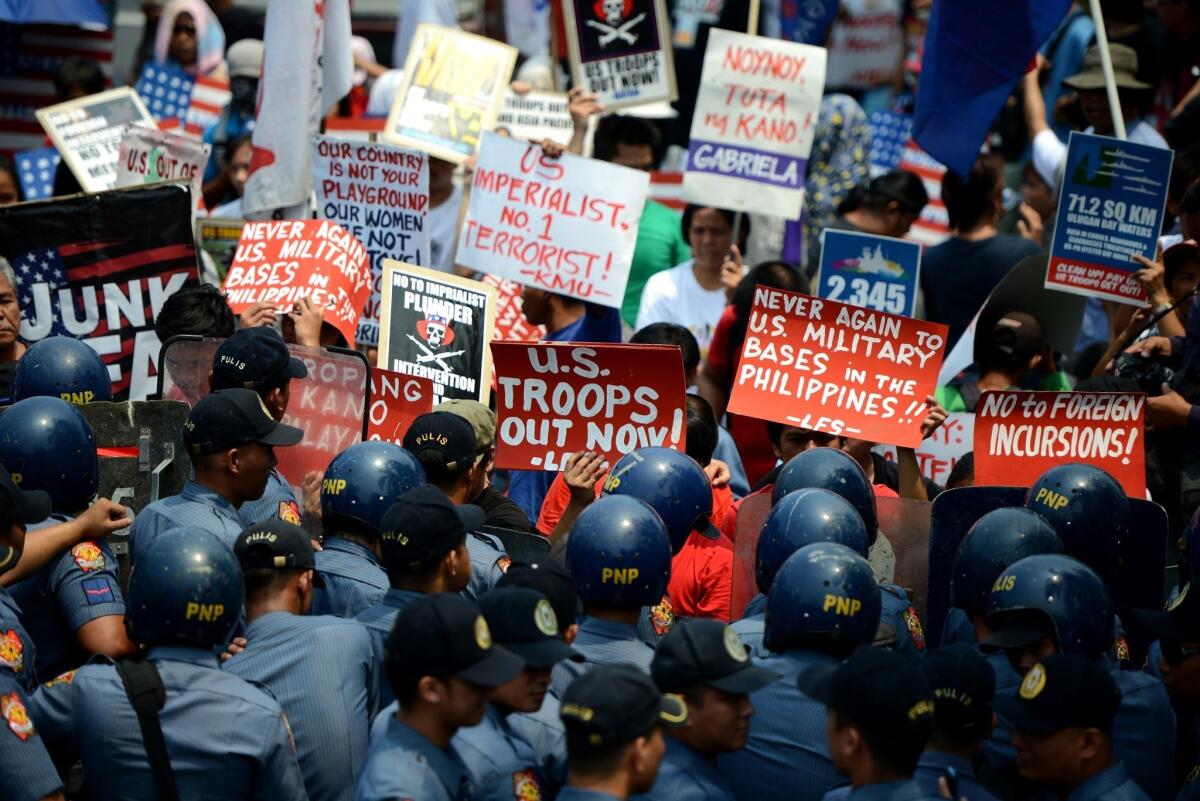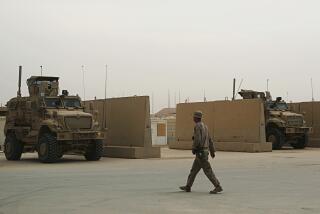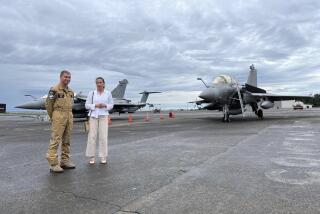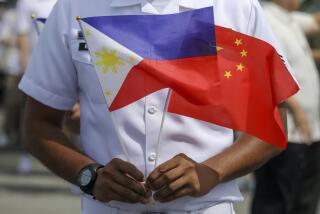U.S., Philippines accord to allow greater American military presence

Reporting from Kuala Lumpur, Malaysia — The U.S. and Philippine governments have worked out a new defense cooperation agreement that opens the way for the first large-scale return of American military forces to the island nation since their eviction in the early 1990s, according to the White House.
A day before President Obama is scheduled to arrive in Manila, advisors to the president said Sunday that the two sides had completed and will sign a framework accord that will allow U.S. troops, warships and aircraft to operate from Philippine military bases and training camps on a rotating basis.
Demonstrations erupted outside the U.S. Embassy in Manila last week to protest the new security agreement with the Philippines’ former colonial ruler. Leftist groups long have accused Washington of interfering in local affairs, and blamed the U.S. for many of their nation’s post-colonial woes, including widespread poverty and decades of political repression.
The accord, which was negotiated over eight months, does not authorize building permanent U.S. bases or stationing large numbers of troops in the Philippines, which would be prohibited under the country’s constitution without a formal treaty.
In some cases, however, portions of the Philippine installations will be refurbished and used to pre-position U.S. supplies and equipment in the event of regional crises or humanitarian disasters.
U.S. Ambassador Phil Goldberg will sign the accord with the Philippine’s defense minister, Voltaire Gazmin, early Monday before Obama arrives in Manila, U.S. officials said.
The security arrangement is still a work in progress, however. Officials said its timing, scope and duration were still subject to negotiation.
Officials say the Enhanced Defense Cooperation Agreement can take effect without specific approval by the Philippine Senate, which in 1991 rejected an extension of a long-standing base agreement and forced Washington to close Clark Air Base and Subic Bay Naval Base, two of the Pentagon’s largest overseas facilities.
More than two decades after that ouster, the new agreement marks an improvement in U.S. relations with Manila, as well as recognition of the growing regional tensions with China over resource-rich islands and shoals in the South China Sea.
“It shows how far we’ve come in building out a very mature partnership based on mutual interests and mutual respect,” said Ben Rhodes, deputy national security advisor to Obama.
The agreement will be Obama’s most visible achievement from his visits to Japan, Korea, Malaysia and the Philippines.
Over the last six days he has attended state dinners, visited cultural sites and held closed-door conversations with Asian leaders. But he will return to Washington on Tuesday without a clear breakthrough on the proposed 12-nation Trans-Pacific Partnership free trade deal that he had hoped to show for his week abroad.
The White House has downplayed that shortfall, arguing that the four-year effort to negotiate an ambitious trade deal should be judged over the long term. Obama has told aides he believes he will eventually sign it.
Although the White House announced plans in 2011 to rebalance U.S. strategic priorities to East Asia, including moving more of the Navy to the western Pacific, it has made clear that it did not intend to rebuild the vast U.S. military bases and installations that once stretched from Thailand to Okinawa.
Plans call for a much smaller, but still visible, U.S. footprint in the region.
In addition to using Philippine bases, the Pentagon is eyeing a return to Thailand and Vietnam to bolster allies nervous about China, which has invested heavily in its military and has engaged in territorial and maritime disputes with its neighbors.
The arrangement in the Philippines follow the same model the Pentagon has used in Australia, which has agreed to allow regular, six-month deployments of Marines.
As part of the deal with Manila, the U.S. is promising to step up military assistance and training with the Philippine military, a strategy aimed in part at deterring China from using force to seize the Spratlys, low-lying islands that the Philippines also claims.
White House officials, who have sought to stay neutral in the territorial disputes, say the expansion of the military alliance with Manila is meant to help prevent proliferation of weapons of mass destruction, fight transnational crime and improve the delivery of aid after typhoons and other natural disasters. The U.S. military provided extensive help after Typhoon Haiyan struck the Philippines in November.
“We’re not doing this because of China,” said Evan Medeiros, senior director for Asia at the National Security Council. “We’re doing this because an enhanced rotational presence … was something that was needed by the Philippine government.”
The Pentagon is seeking nearly $50 million in foreign military financing for the Philippines, nearly twice what it provided last year.
It is promising to help the Philippines acquire naval patrol ships and patrol aircraft to expand its presence in the South China Sea and to expand joint training with the Philippine armed forces.
The two countries have cooperated closely on counter-terrorism operations since 2001. The Pentagon has kept about 600 special operations troops in the Philippines to assist their campaign against the Muslim extremist group Abu Sayyef in the southern part of the archipelago.
The historical arc of America’s relations with the Philippines reaches back more than a century, starting with the U.S. ouster of colonial Spain from the islands after the Spanish-American war, and then a brutal U.S. military campaign to crush a Philippine independence movement.
Run as an American colony for the first half of the 20th century, the Philippines did not gain independence until after World War II.
During the Vietnam War, Clark Air Base and Subic Bay Naval Base were two of the Pentagon’s most important overseas military installations, with vital deep water port facilities and runways long enough for B-52 bombers. The bases also played a key support role during the Persian Gulf War in 1991 before they closed.
They became favorites of generations of sailors, airmen and Marines for the cheap drinks and friendly bars with names like “Top Gun” and “Foxy Lady” just outside the gates.
Many Philippine nationalists still resent the decades of U.S. support for President Ferdinand Marcos, a corrupt autocrat who finally was ousted in 1986 in the People Power uprising. The new elected government ordered the U.S. bases closed five years later.
ALSO:
Philippines agrees to large-scale return of U.S. military forces
Captive observers in Ukraine meet journalists under eyes of gunmen
Canonization of predecessors provides another boost for Pope Francis
Twitter: @cparsons
Twitter: @DavidCloudLAT
Staff writers Parsons reported from Kuala Lumpur and Cloud from Washington.
More to Read
Sign up for Essential California
The most important California stories and recommendations in your inbox every morning.
You may occasionally receive promotional content from the Los Angeles Times.











